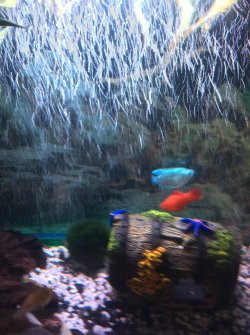Bruce Leyland-Jones
Fish Aficionado
Tank No.2

Planted in sand and, by necessity, weighted down by strategically placed pebbles, is Eleocharis acicularis, or Hair grass. The resident kuhli loach love to writhe through this, in search of titbits and, somewhat problematically, they also like to burrow under the roots and between the plant and the stones. (Please forgive the reflection ).
).

To the left is some A. reineckii, planted from Tank No.1 to facilitate cycling.
NOTE the Hairgrass, again secured by wood and pebbles.
The small plant attached to the base of that piece of wood is Cryptocoryne beckettii. Note that this is not buried and that it's rhizome is just above the surface of the sand.
The background shows a Java fern and, to the right, is the beginnings of my Vallisneria spiralis plantation. These are individually planted, relatively deep into the sand and, so far, seem to be resisting the interests of the kuhli loach.

The floating plant is Salvinia auriculata. All I had to do for this to grow like nobody's business, was to put it on the water. It's dangling roots attract a lot of interest from shrimp, kuhli loach, Tyrion and the cherry barbs. I don't have measurable nitrates in the water, either.
The big feathery plant, centre stage, is Limnophila sessiflora, or Dwarf abulia. This is also doing exceptionally well. Trimming produces viable cuttings and a second group of this plant has now been established to the left of the 'mother' plant. Occasionally, algae will appear on the fronds, but I note that this is gone by morning, thanks to the shrimps doing their thing.
EDIT: Plant names in bold.
Planted in sand and, by necessity, weighted down by strategically placed pebbles, is Eleocharis acicularis, or Hair grass. The resident kuhli loach love to writhe through this, in search of titbits and, somewhat problematically, they also like to burrow under the roots and between the plant and the stones. (Please forgive the reflection
To the left is some A. reineckii, planted from Tank No.1 to facilitate cycling.
NOTE the Hairgrass, again secured by wood and pebbles.
The small plant attached to the base of that piece of wood is Cryptocoryne beckettii. Note that this is not buried and that it's rhizome is just above the surface of the sand.
The background shows a Java fern and, to the right, is the beginnings of my Vallisneria spiralis plantation. These are individually planted, relatively deep into the sand and, so far, seem to be resisting the interests of the kuhli loach.
The floating plant is Salvinia auriculata. All I had to do for this to grow like nobody's business, was to put it on the water. It's dangling roots attract a lot of interest from shrimp, kuhli loach, Tyrion and the cherry barbs. I don't have measurable nitrates in the water, either.
The big feathery plant, centre stage, is Limnophila sessiflora, or Dwarf abulia. This is also doing exceptionally well. Trimming produces viable cuttings and a second group of this plant has now been established to the left of the 'mother' plant. Occasionally, algae will appear on the fronds, but I note that this is gone by morning, thanks to the shrimps doing their thing.
EDIT: Plant names in bold.
Last edited:




